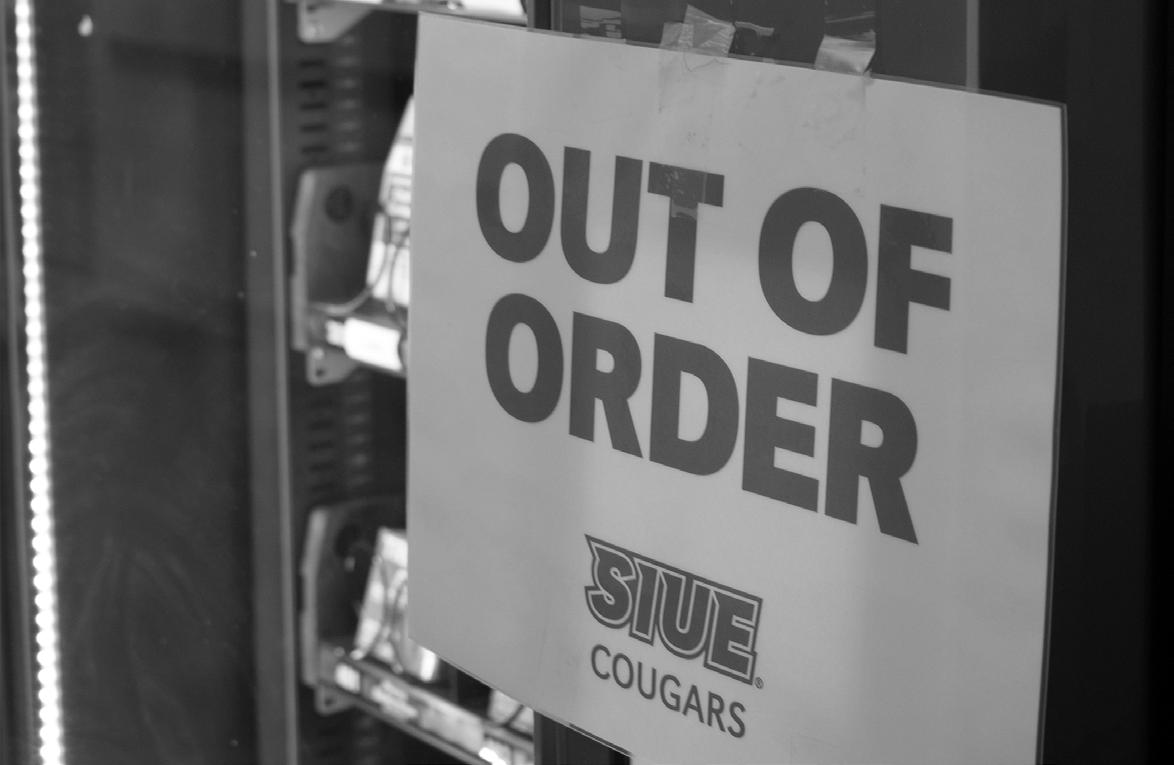alestle THE





While students fight in the bathrooms at some Edwardsville district schools, community members say Superintendent Patrick Shelton and the Board of Education have done nothing to stop it.
Shelton was hired as the new superintendent in 2021 after the departure of Jason Henderson. Since then, according to multiple district parents and employees, some schools in the district — particularly Edwardsville High School — have seen a decline in safety.
The Alestle attempted to reach Superintendent Shelton three times for an interview. The first time, Shelton redirected the request to Public Relations and Communications Coordinator Mary Ann Mitchell. There was no response from Shelton at all the second or third time.
three consecutive years. This is done by analyzing district reports at the end of the school year to determine if the problem has improved.
However, if the district fails to improve, the state has no specific action to remedy the situation, according to a representative from the Illinois State Board of Education.
Scott Ahart, a newer member of the District 7 Board of Education, tried to bring these issues to the board’s attention in October 2023, before he became a board member. Ahart told the board that their inaction was “emboldening these kids to do more.”
“ I grabbed his bookbag, and he turned around and punched me in the face repeatedly.”
Matt BreihanFormer District #7 School Resource Officer Coordinator
In addition, The Alestle tried to contact Board President Jill Bertels for an interview. Again, the request was redirected to Mitchell.
A district with a discipline problem
District 7 is currently under a Discipline Improvement Plan from the Illinois State Board of Education due to a disproportionate number of students of color being suspended or expelled over a threeyear period.
According to the Illinois Report Card, in 2022, almost 9.5 percent of all students of color in the district were suspended or expelled, while just under three percent of all white students received the same disciplinary measures. In 2022, there were 5,771 white students and 1,476 students of color.
While these rates have somewhat improved since then, the district is still under state supervision for racial disproportionality across the district.
Schools in Illinois are automatically put on the Discipline Improvement Plan if they are among the top 20 percent of schools that use exclusionary discipline and have done so for three years. To move past the Discipline Improvement Plan, the school district must get off this list for
The district’s response to being put on the Discipline Improvement Plan was the implementation of Responsibility-Centered Discipline. Responsibility-Centered Discipline is a concept that centers on “students taking responsibility for their own behavior as well as their own academic success,” according to its website.
Responsibility-Centered Discipline is meant to allow students time to “cool off and prepare to move forward” before discussing a disciplinary measure with an educator. According to its website, Responsibility-Centered Discipline has resulted in a 40 percent reduction in discipline referrals after just one year.
The Edwardsville Education Association, a union representing educators in the district, addressed perceived issues with Responsibility-Centered Discipline in an April 22 letter to Shelton and the board. The number of suspensions and expulsions has decreased since the implementation of the approach, but members of the union said the plan has been rolled out ineffectively.
“A number of staff members have not fully completed RCD training at this point … Staff members know that consequences are rarely assigned, and those that are assigned are often not enforced,” the letter said. “Staff members are actively avoiding writing referrals, as they know such a referral will likely only create more work and headaches for them, the student will likely not receive or serve any consequences, and ultimately, the only outcome
is an erosion of that teacher’s authority in [the] classroom.”
Unpacking the safety crisis
Matt Breihan was a sergeant with the Edwardsville Police Department, as well as the district’s school resource officer coordinator when Shelton took over as

them refused to get searched and walked away. So, I grabbed his bookbag, and he turned around and punched me in the face repeatedly.”
Breihan reported this incident to the Board of Education after sustaining a black eye. This incident was two and a half years ago, and Breihan said he was never
superintendent. Breihan resigned in the summer of 2022.
During his time with the district, Breihan said he overhauled outdated active shooter plans, trained over 1,000 teachers and staff in safety procedures — such as the Homeland Security-endorsed “Run, Hide, Fight” plan — and regularly presented safety reports.
Breihan said he witnessed safety issues, including physical violence, at Edwardsville High School daily.
“It’s the culture — in my opinion, the lack of responsibility [on the part of the district] that makes it dangerous,” Breihan said. “Everything that police officers deal with in the real world happens inside of District 7.”
In Dec. 2021, Breihan got caught in the crosshairs.
“The assistant principal had caught a bunch of students in the bathroom using drugs,” Breihan said. “We had them out in the hallway to search them all. One of
contacted by the district and nothing has changed following the incident.
In his departure report from July 2022, Breihan said that he had filed numerous safety audits for a few years leading up to the beginning of the COVID-19 pandemic. Part of the reason for discontinuing the audits, Breihan said, was “finding the same unresolved issues,” such as weak points in the district’s safety plans, that were never addressed by the district.
BRANDI SPANN opinion editor from traditionally under-resourced communities.
Beginning June 10, SIUE will host a six-week Children’s Defense Fund Freedom School experience for 50 local middle school students.
“The entire premise of the program is not to teach students how to read, but to teach them the love of reading,” Program Director and Assistant Professor of Literature Cindy Reed said. Reed said that the visionaries for the Freedom School wanted to create a summer camp that was both intellectual and engaging. The target scholars for this experience are those who come
Anyone can participate, and the goal of the Freedom School is to provide participants with positive role models, aid in food insecurity and stimulate intellectual curiosity during the slump of the summer months.
“They [the visionaries for the original Freedom Schools] call the program participants ‘scholars.’ You gotta love that, right? It gets them to see themselves as intellectuals,” Reed said.
“I want to speak to you in a way that I want you to respond in and model for yourselves. You’re thinkers, you’re scholars.”
This methodology is meant to encourage young people to
recognize their own potential.
“We want these middle schoolers to see themselves as people who could be in college one day. What better way to encourage them to think of themselves and their academic futures than hosting at SIUE?” Reed said.
Vice Chancellor for Anti-Racism, Diversity, Equity and Inclusion Jessica Harris shares this enthusiasm for investing in young scholars.
“I think it’s a showcase of how important it is for the university to invest in young people in our communities and the need to expand our educational mission beyond the students who are directly enrolled at the
institution,” Harris said. “The way that I see it, we’re investing in your future Cougars, and I definitely think it’s well worth the investment.”
Police calls for potentially violent crimes increased drastically after Shelton was appointed, according to police reports between 2016 and 2024. There have been six battery reports in the 2023-2024 school year alone, as opposed to just three between 2016 and 2020. Calls marked as “disorderly,” which Breihan said typically mean fights, numbered roughly five per year between 2016 and 2020. In the 2021-2022 school year, that number munities,” Harris said.
The Children’s Defense Fund Freedom Schools began during the Civil Rights Movement.
“The lineage of the Freedom School concept goes back to the 1960s — particularly the 1964 Freedom Summer project in Mississippi — when you had college students and activists from across the country go to the state of Mississippi not only to register African Americans to vote, but also to provide educational programming for the students and the young people in those com-
The Freedom School was created as a response to the racial inequalities in access to education that persisted despite the Brown vs. Board of Education decision to eliminate the “separate but equal” segregated school systems in 1954.
Days traditionally begin with Harambee at Freedom Schools. Harambee is a Kiswahili word meaning “let’s pull together.” This is a dedicated time for singing, chanting and read-alouds. It is an opportunity for Student Leader Interns and participating scholars to energize in a fun, comfortable environment.
SAFETY | COVER
increased to 11, and then to 21 the following school year.
In addition, police reports show that “ordinance” calls increased after Shelton was appointed. Ordinance calls are typically for drug or alcohol infractions. Between Aug. 2021 and Feb. 2024, there have been 154 ordinance calls, as opposed to 72 between 2016 and 2021.
Breihan also said that student drug use has continued to be a significant issue in the district. While marijuana and vaping are the usual suspects, Breihan said that police have also recovered acid, psychedelic mushrooms, and that a couple of students have used heroin.
In his 2022 departure report, Breihan noted a “negative culture change” around discipline in the district. Included in his report were instances when unauthorized visitors entered
the building and students were violating the closed campus rule by leaving the campus during the school day. Breihan said one of the reasons he ultimately left was due to safety being “put on the back burner” by the district.
Most parents’ complaints center around a lack of supervision over key points in and around the school buildings.
One district parent, who wished to remain anonymous due to fear of retaliation against their child from the district, recalled an incident in March in which a 7-year-old Leclaire Elementary student in Edwardsville’s CASTLE Program, a program developed for students with autism, left the school premises, walked six houses down the street and managed to cross the street with no adult supervision.
“All of the special education programs are severely understaffed across the district,” they said. “They don’t pay well. They don’t get the support they need.”
District parent Andrea Painter said an unhoused person in mental distress entered the
high school cafeteria one morning a few years ago, where hundreds of students were gathered before classes began.
“I got a text message from my daughter that said, ‘Mom, I just want to let you know, if you get an email or call from the school, I’m okay,’” Painter said. “I’m trying to message her back [and] I’m getting nothing. My mind automatically went to the worst case scenario.”
Painter said the man was “flailing his arms around” and had his pants down around his knees, likely in the midst of a “mental episode.” She said that there was no email from the school by the end of the day, and a district affiliate told her that the officer assigned to that particular entrance to the building was at a doctor’s appointment.
In the officer’s stead, an administrator was stationed to monitor the doorway but was pulled into a meeting soon afterward, leaving the doorway unsupervised.
“There’s no meeting that’s worth one kid getting a hair harmed on their head,” Paint-
er said. “If something would have happened that was serious — if you think that you’d be able to stand here and tell me that this administrator got pulled away for a meeting and that’s why my kid got hurt — that’s not going to work for me. That’s unacceptable.”
Several other district parents have concerns about the lack of monitoring in the hallways and around the bathrooms, where there are frequent fights.
“Students understand what they can get away with, [and] they know where they can get away with stuff,” another district parent, who also wished to remain anonymous due to fear of retaliation against their child, said. “It’s not uncommon for incoming freshmen to reach out to upperclassmen to see which bathrooms are safe.”
SCAN HERE FOR MORE ABOUT THE BATHROOM DEBATE AND ADMIN INACTION

06.02.24
Officer responded to a report of subjects on four-wheelers doing burnouts. Officer advised subjects were gone on arrival.
06.09.24
Officer responded to a report of subjects that were in kayaks on the lake. Officer advised subjects that kayaks were not allowed on the lake.
06.10.24
Officer responded to a report of a possible fire in a dumpster. Officer advised fire was extinguished before arrival.
Subscribers to Sling TV may not know that their customer experience on the landing page was created by an SIUE alumna.
Caitlin Lally was editor-in-chief of The Alestle for the 2016-2017 academic year, and is now a web content manager for Sling TV, a streaming network. Her path to journalism in college, however, was “a windy road” through various sciences.
Lally was hired as a copy editor at The Alestle by Hailey Huffines, the editor-in-chief for the 2014-2015 academic year. Huffines said they remember Lally as a go-getter.
“She would really probe deep into issues. I knew that this was someone who not only is going to ask those difficult questions, but is not afraid to get down and dirty with journalism,” Huffines said. “We’re not a PR company — we’re doing the nitty-gritty investigative work. She had a grasp of what it
meant to be a journalist — she found her footing very quickly at The Alestle.”
Eventually, Lally applied for the position of editor-in-chief. Huffines said they were confident in Lally’s abilities as editor-in-chief from the beginning.
Lally overhauled the design of The Alestle during her tenure as editor-in-chief, transitioning from a fullpage magazine cover to a more traditional news cover.
wasn’t a full page of text, [and] it wasn’t overly playful. It was one of my favorite designs because it geared the attention right where it needed to be.”

Lally also presided over the redesign of The Alestle nameplate into the “Bebas Neue” font still used today.
Lally said she had a lot of fun designing covers, with one of her favorites being the issue that came out immediately after the 2016 U.S. general election.
“It’s very clean and simple. It was about the protests that were happening on campus during election season,” Lally said. “It
However, the position was not without its difficulties. In March 2017, two years after she started at the paper as a copy editor, Lally checked herself into a psychiatric ward at the advice of her therapist.
“We started unpacking stuff, I started spiraling, and [my therapist] said I should get somewhere safe,” Lally said. “I was having a really hard time juggling school, work, social life [and] the pressure of being a visible person on campus to administrators.”
“The hardest part about being in all of that was facing these mental health issues that were bubbling under the surface,” Lally said.
Lally said the 2016 election was likely a contributing factor
If there’s one constant, it’s a broken vending machine. The only thing that’s worse than not being able to get your favorite snack out of the vending machine is not being able to get your ibuprofen out of the vending machine.
A new machine arrived on campus this year offering various medications and other health-related products to students in the Student Success Center. However, there is only one, and not only is it already out of order, but it has been for quite a while now.
After many weeks of confusion, there is now insight into why it’s out of order and the solution to get it back up and running.
Miranda Wilhelm, a clinical professor in the School of Pharmacy, said she is one of the people responsible for deciding which products are placed within the wellness kiosk, keeping it
stocked and ensuring the inventory is up to date.
Wilhelm said that the reason the vending machine has been out of order for so long is due to contractual complications.
“Unfortunately, there have been some technical difficulties with the payment processing. The university has to make a contract with the credit card machine to be able to pay through the kiosk, and that has been in contract negotiations,” Wilhelm said.
This machine provides items for medical support such as generic Plan B, generic Zyrtec, generic Mucinex, laxatives, topical antibiotic ointment, tampons and condoms.
Wilhelm said that the kiosk came to fruition out of legal obligation to provide emergency contraception.
“The state of Illinois passed a law [Senate Bill 1907] that required all public institutions of higher education to provide emergency contraception for sale in some type of a vending machine,” Wilhelm said.
Wilhelm said that the kiosk is a necessity because students are likely to need these resources after the other campus services have closed.
“It offers access to emergency contraception, but also other health-related products and selfcare products for students when Health Services or the Union Station are not available,” Wilhelm said. “It helps students to be able to get easier access to time sensitive medications that are also cost-effective.”
Business Manager of Health Services Molly Bohnenstiehl said the machine is greatly beneficial for students with limited transportation options.
“If the [MUC] is open, students have access to the kiosk so they can get [necessary medical] products. I think sometimes that does affect students’ mental health if they’re worried about things like that,” Bohnenstiehl said. “I think that puts them at ease that they do have that available, and they can get that at any
to her stay at the hospital.
Lally graduated from SIUE in 2017 and freelanced for the next few years at the Belleville News-Democrat and Sauce Magazine. Soon enough, Lally found herself in the midst of election season again in 2020 while working for a radio station.
“I kind of crumbled under the pressure a little bit. I ‘got out’ [of journalism] right before the 2020 election,” Lally said. “My journalistic integrity was like, ‘Hey, this feels weird,’ but that’s how these opinion outlets run, and I needed out.”
However, Lally said she realized many of her skills were transferable to similar careers.
“Throughout all of this, I was dealing with websites, and that transferable skill pushed me to pivot. I wanted to take a break from news, but I could use my communication skills to help brands tell their stories,” Lally said. “Ultimately, I like telling stories and informing people about things that they didn’t
know about before. That’s at the root of how I still operate.”
Lally took her current job as a web content manager for Sling TV in October 2022.
Lally said her proudest accomplishments at Sling TV revolve around the experimentation she has been able to implement in her role.
“The number of experiments we’ve been able to do as a team and the amount of knowledge I’ve amassed about this specific platform... those skills that I’ve acquired are really valuable to me.”
Lally said she plans to explore her opportunities in web content management for the foreseeable future. Though she doesn’t have any definitive plans for the future of her career quite yet, she said it’s fulfilling to be helpful to her clients.
“I’m really excited to focus on this niche,” Lally said. “It’s exciting to me when I get to work on a project, and I know I’m doing a really helpful thing for a small business owner.”

time if they need it. Sometimes transportation isn’t always the easiest for students around here, so that way it’s available.”
The likelihood of increasing the number of machines around campus would depend on the success of the first one, according to Wilhelm.
“Although there currently aren’t any plans for additional
machines, there has been significant interest from the students [to add more], so Health Services will have to look into that,” Wilhelm said. “I think there are potential opportunities for growth in the future for kiosks and other locations on campus. It just depends on how much this one gets used.”










Transgender people are often misrepresented in the media through offensive stereotypes, portraying them as unintelligent, sinful or promiscuous.
Many movies and documentaries depict this. In the documentary about Brandon Teena’s life, as well as in accompanying news stories, the narrative often implies that he deserved his incredibly brutal death. Teena was raped and beaten before being fatally shot in the head. Despite his dying wishes, he is still referred to as a woman.
HAVE A COMMENT?
Let us know by scanning here: Campus Box 1167 Edwardsville, Illinois 62026-1167
LETTERS TO THE EDITOR POLICY:
The editors, staff and publishers of The Alestle believe in the free exchange of ideas, concerns and opinions and will publish as many letters as possible.
Letters may be submitted to: The Alestle Morris University Center Room 0311
All hard copy letters should be typed and double-spaced.

While the documentary is meant to be informative, society has no need to continue this blatant disrespect of the dead. Transgender characters, both real and fictional, are frequently portrayed as objects of pity, reinforcing harmful stereotypes that people who transition are weak.
In the film “Dallas Buyers Club,” the portrayal of Rayon, a transgender woman, as a
drug-addicted prostitute not only reinforces one-dimensional representations that fail to capture transgender experiences, but also promotes dehumanizing biases that imply transgender people are not people.
A common trope seen in both nonfiction and fictional media is the depiction of transgender individuals solely through the lens of their transition. While transition narratives are undoubtedly crucial, reducing transgender characters to their transition process oversimplifies their experiences and reinforces the notion that their identity revolves solely around their physical transformation.
For example — Buffalo Bill from “The Silence of the Lambs.” In the movie, it is revealed that the reason Buffalo Bill has been killing women and wearing their skin is due to the fact he was not allowed a sex change operation.
The lack of authentic transgender representation in media not only erases the diverse experiences within the transgender
community, but also perpetuates harmful stereotypes that fuel discrimination and violence.
According to a report by Gay and Lesbian Alliance Against Defamation, only 16 percent of Americans personally know someone who is transgender, meaning that for many, their only exposure to transgender individuals stems from media representation.
When these portrayals are riddled with generalizations and misconceptions, they not only shape public perception, but contribute to the systematic marginalization of transgender people.
However, recent years have seen an increase in media productions that strive to authentically depict transgender experiences.
The groundbreaking series “Pose” has been applauded for its modern portrayal of transgender characters of color within the ballroom scene of 1980s New York City. Similarly, the film “A Fantastic Woman” offers a sensi-
tive and empathetic portrayal of a transgender woman navigating grief and discrimination in contemporary Chile.
These authentic portrayals not only provide much-needed representation for transgender individuals, but also challenge prevailing stereotypes and foster empathy and understanding among audiences.
As the media landscape continues to evolve, it is crucial that the industry strives for authentic representations of transgender individuals that reflect the diverse realities of their lives. With this in mind, the journey towards true inclusivity and representation is far from over. It is important for media creators and consumers alike to demand and support narratives that authentically reflect the diverse experiences of transgender individuals.
By amplifying their voices and stories, we can collectively contribute to a more inclusive and equitable society where everyone’s identity is respected, understood and celebrated.
business records.
Former President Donald Trump is a convicted felon now.
For those who find it difficult to keep track of every controversy Trump has found himself at the center of, this trial was all about falsified documents related to payments he made to Stormy Daniels, an adult film star.
In short, Daniels alleged that she and Trump had a sexual encounter sometime before the 2016 presidential election.
Trump paid her $130,000 in “hush money” to keep the matter private.
Trump’s intimate dealings with Daniels were not the focus of this trial. Instead, the trial revolved around Trump’s reimbursement to Michael Cohen, his former attorney, for the $130,000 payment. This was falsely marked as a legal expense in Trump’s ledgers, which ultimately earned him 34 felony charges for falsifying
More recently, Trump has made several comments about the judges involved in his criminal court cases. Juan Merchan, the judge who presided over the hush money trial, and his family have been the targets of Trump’s posts online.
According to Lilliana Mason, a Johns Hopkins University political scientist quoted in a recent Reuters article, Trump doesn’t need to specifically call for violence for his supporters to take action.
“Trump is constantly riling up his supporters to be angry on his behalf,” Mason said. “He takes that large group of angry people, he points them in a particular direction, and then the judges get all these death threats.”
Trump knows that his words have power over millions in the country. On pro-Trump websites such as Truth Social, this sort of threatening talk has been rampant in direct response to Trump’s comments. Several fol-
lowers expressed their desire for the judge to be “strangled with piano wire” or take “a hatchet to the face” after Trump made a post calling Merchan’s integrity into question.
Trump’s legal team defends this as the former president exercising his First Amendment rights. The First Amendment bars speech that can incite violence.
It’s a common theme in these columns that words carry far more power than people give them credit for. Politicians know this, and politicians like Trump push the envelope as much as they can. Whether you like the president or not, their words carry more weight than anyone else in the country.
No one in a position with as much power as the president can claim ignorance for the actions of their supporters, especially after so many years of repeated violence in the wake of Trump’s rhetoric.
So far, Trump is a convicted felon for falsifying business re-
cords. There are many other incidents in the wake of the 2020 election he has not been brought to justice for yet, such as the phone call where he pressured Georgia Secretary of State Brad Raffensperger to “find” the exact number of votes needed to turn the state red.
This sets a very dangerous precedent for the future — it emboldens wannabe dictators. Just because Jan. 6 failed the first time doesn’t mean the next time will fail too.
Trump is set to be sentenced on July 11. In the meantime, he is just as free as he has been to continue inciting the hateful violence his name has become synonymous with.
The result of the hush money tria l restored my faith in the system ever so slightly, but it isn’t over yet. Trump still needs to be sentenced, and no matter what decision is made, there will be lots of very angry people around the country.
The wheels of justice turn slowly in this country — especially if you’re rich.
contact the editor:
lifestyles@alestlelive.com (618) 650-3528
The Culture Exchange pairs an international student with an American student to foster a friendship and aid in language development.
Shengbei Guan is an international student from China. She is a first-year student studying in the Intensive English Pathway program. She said that the program helps her to learn more about American culture, and to improve her speaking and writing.
Director of the Intensive English Pathway program Asha Mattan began the Culture Ex-
change to support her students.
“I started [the exchange] because I noticed that a lot of my international students who were coming to SIUE and to the U.S. for the first time were really excited to meet American students and make American friends,” Mattan said. “But every semester, I noticed that they were really struggling with that, because they were shy and a little bit self-conscious about their English.”
The program has included international students from many different language backgrounds. This past semester, Mattan worked with Chinese students.
Sophomore Zephina Vaz de Carvalho is an American student studying flute perfor-
mance and music history. While studying Chinese, her professor introduced her class to Mattan’s program.
“As a person who has lived overseas myself, one of the best ways to learn a culture or learn a language is to speak with people that are fluent in that language,” Vaz de Carvalho said. “In an educational setting, you only get the very formal [language], or the writing styles. But when you can converse with someone … it becomes more conversational. They can learn English faster, but I can also learn Chinese a little bit faster.”
Vaz de Carvalho said that this program is both social and educational, and it offers an op-

Caribbean
Co-founder of the Juneteenth Caribbean Heritage Festival and Africans Rising Together 2063 President James Tucker is eager to educate the youth and pass on the unknown history of Juneteenth.
portunity for students to practice their language skills in a relaxed environment.
“You can definitely see the improvements in English speaking over time,” Vaz de Carvalho said. “The walls come down a little bit, so it’s not as awkward anymore. That first meeting, we didn’t know what to say, because there were a lot of barriers that were in between us. But as time went on, and we met with each other more, it became a lot easier to converse and have fun.”
Mattan’s intentions with the program were to emphasize the practice of language outside of a classroom setting.
“They’ll meet at a coffee shop or go to the mall together, and they’re able to have these American cultural experiences that they want to have, but don’t necessarily know how to create for themselves,” Mattan said. “They’re able to make new friends and have more fun on campus.”
Vaz de Carvalho said she enjoyed trying authentic meals, eating tofu and drinking tea made for her by her language partner.
Second year nursing student Shelby Rainey shared this enthusiasm for new foods. She said that she enjoyed shopping at supermarkets and trying soup dumplings with the friends she made
through the program.
“Something that was really great was that they would take me to places in St. Louis that I had never been to before that had a lot of cultural food. Where I am from, the most I’ve had is Panda Express,” Rainey said.
Rainey was adopted from China at 11 months old.
“Whenever I get to meet the Chinese students, in a way, I feel connected with them already,” Rainey said. “I already have a Chinese name [Feng Chuan or Chuan Chuan] … I call them by both their Chinese and their American name on and off, and they call me by my Chinese name and my American name on and off.”
“Something that they’ve taught me is that, in the Chinese language, there is no past, present or future tense,” Rainey said. “They’ve taught me a little bit of Chinese. I knew the basic hello. But I asked what to say if I wanted to tell my parents ‘I love you’ It’s like ‘Wǒ ài nǐ.’” Mattan said that American culture can be hard to acclimate to.
“I think the more programs that the university can create to support international students, the better. It’d be great if we could create more communal events and activities to bring students together,” Mattan said.
voter registration.
The African Arts Festival, now in its 33rd year, is an annual event in St. Louis intended to educate and engage with the community.
Founder and Executive Director Cynthia Cosby said she found inspiration for the festival from the National Black Arts Festival that started in Atlanta, Georgia, in 1988.
“It started off as part of the African Studies Conference in 1991 when we were a component of that. It was somewhat of a tester to see if St. Louis could support such an event, because we knew it was different,” Cosby said. “But the way it was planted, there was something for everyone. It was such a hit.”
Cosby said that she wanted the art festival to be a family-oriented event that brought everyone together and would benefit individuals of all socioeconomic backgrounds.
Cosby said that she loves how the festival has continued to grow and greatly values the feedback from attendees.
“We want to continue with our expansion. We’re always looking for something new, and we do a survey every year to solicit feedback,” Cosby said. “We would like to have more frequent international events, but if not, then we would love to have some of the national and internationally renowned artists. We’d like to break out of our comfort zone.”
The African Arts Festival offers an array of attractions each year centered around African heritage. From food and art to clothing, plants for sale, performances and history lessons, attendees can immerse themselves in various aspects of African culture.
This year, volunteers even assisted those in attendance with
Volunteers Mary Ann Meyer, Harry Meyer, Ruth Carter and Mary Carter took their time to talk people through the registering process. Mary Ann Meyer said that everyone should have the chance to vote, as it is their right.
Marshanette Densmore comes to the festival every year with her ancestry memorial that is designed to honor and remember her ancestors and deceased loved ones. She emphasized the significance of remembering and honoring ancestors, referred to as “egungun” in Yoruba, as they live on through us even after their physical departure.
“Your ancestors are who you are through your bones — through your DNA — and that is something that we must really understand — acknowledging the impact that they had on our lives,” Densmore said. “My ancestors are some of the people that we have displayed here have molded me in so many ways. They have directed me, protected me and given me guidance so that I can be a successful young lady and enjoy this human experience that we all have.”

Marshanette Densmore comes to the festival every year with this display to memorialize her ancestors and invites attendees to the same. Below the pictures of her loved ones, she’s placed food, beverages, fowers and other items that these people once loved. The altar was near the St. Louis Zoo’s Butterfy House. Butterfies have been thought of as ties to ancestors throughout history. Many believe that they symbolize souls passing on and others believe that they are messages from deceased loved ones letting them know they are well.
more said. “It’s very important to share their knowledge, especially to the children. Not even just to your children, your children’s children.”
Upon a tree she places the images of her loved ones, decorations and offerings of food, beverages and gifts that they enjoyed when they were living.
Densmore honors ancestors and passes down their memories to future generations as far as possible.
“The more you really embrace the ones that came before you, the more you will know about who you are,” Dens-
Cory Lampkin, Jr. is an artist with a passion for making people feel seen. He said that it’s important to him to show people how to develop a new way of thinking through art.
“I understand that there’s kids and adults that come through [the festival] that don’t get to see Black representation with things that they connect with,” Lampkin said. “I show up to make sure that individ-
| Camela Sharp / The Alestleuals have opportunities to see things that they’ve never imagined before so that it helps them think outside the box.”
Adrian Smart and Ceciliya Smart, a couple attending the festival, found that the experience was a rare opportunity to bask in their culture, stating that the environment felt like home.
“It’s not often that I get the chance to see our culture displayed on such a massive scale,” Adrian Smart said. “Living in a world that is ver y Eurocentric, this experience is a breath of fresh air.”
“If you walk in and you make the beautiful, good mistake of saying, ‘good morning, everyone,’ guess what you’re going to be greeted with? ‘G-O-O-D M-O-R-N-I-N-G GOOD MORNING!’” Reed said.
Recent SIUE graduate and Student Leader Intern Makayla Mallon spent a week at national training in Knoxville, Tennessee, alongside the six other student leaders that have been hired to teach this summer.
Mallon said that training included Harambee, discussion on social action and the ways that scholars and Student Leader Interns can help the community, Integrated Reading Curriculum workshops and conversations about writing books for kids and scholars.
“I remember in one of our training sessions, we had somebody come and tell us the history [of the Freedom School], and there was this moment that really stood out to me,” Mallon said. “The first week of one of the Freedom Schools, three people went missing and were murdered. Because, of course, Black folks coming together and in solidarity to fight for something that goes against white supremacy and racism is a danger to the people in power.”
Mallon said that the history of the Freedom Schools greatly impacts the way that the experience is run today.
“I want people to know that it’s not just about literacy. It’s not just about instilling a love for reading and books and education in our young and our schol-
ars,” Mallon said. “It comes from a rich history, and it’s about instilling ideas of self-love, but also a sense of an obligation to our community, and to the U.S., and really, to the world, to uplift but also to fight for our rights.”
Mallon said that their position as a Black woman and historian motivates them to share their love of literature and
transformative to instead take an opportunity like Freedom School and teach young scholars how to enjoy learning.
“That’s the part that’s infectious,” Reed said.
Alongside daily education at the Edwardsville campus, Reed said there are events planned for East St. Louis and the surrounding area to provide outreach op-

stories with substance to young scholars.
“A lot of people see kids as if they don’t know anything. But really, they know so much, and they have such great ideas,” Mallon said. “I was thinking about myself in eighth grade. I really did have quite a good sense of the world, and I had ideas, too. The thing I’m most excited about is hearing our scholars share what their ideas are.”
Reed said that educators often follow a teach-to-the-test pedagogy. So, it’s
 OLIVIA WHITLOCK
copy editor
OLIVIA WHITLOCK
copy editor
Happy Pride Month! Here are a couple of LGBTQ+ flms that I have personally enjoyed and recommend everyone watch this month.
Please visit websites such as “Does the Dog Die?” to check for potential triggers and sensitive topics before viewing any movie on this list.
‘Saving Face’ (2004), Director Alice Wu “Your hot dog got cold, so I fed it to the birds.”
In this touching movie about going against cultural expectations, Wil (Michelle Krusiec), who is closeted to her family, begins dating a woman. Their new relationship becomes strained due to Wil’s demanding career as a surgeon and her 48-year-old pregnant mother moving in with her.
‘Tangerine’ (2015), Director Sean Baker “Los Angeles is a beautifully wrapped lie.”
Filmed using only three iPhone 5s, this movie follows two transgender sex workers, Sin-Dee (Kitana Kiki Rodriguez) and Alexandra (Mya Taylor), who are in search of Sin-Dee’s unfaithful boyfriend after she gets out of jail. This chaotic journey tests the limits of their friendship.
portunities that “keep our roots rooted.”
“We want to make sure that we are supporting our broader university goals around community engagement and that the communities and the families that surround us know that SIUE is a partner,” Harris said.
The Freedom School is provided at no monetary cost to the participants. Reed said that the cost to families is in the expectation of engagement and time com-
‘Velvet Goldmine’ (1998)
Director Todd Haynes “I want to be a pop idol.”
Bisexual glam rock superstar Brian Slade (Jonathan Rhys Meyers) fakes his death at the peak of his career in the ‘70s and disappears from the public eye. A decade later, former fan and journalist Arthur Stewart (Christian Bale) is tasked with investigating his whereabouts by revisiting his past, delving into the fuidity of identity and the struggles of stardom.
‘Cowboys’ (2020), Director Anna Kerrigan “Cowboys eat beans. I wonder if they fart a lot?”
Troy (Steve Zahn) takes his transgender son, Joe (Sasha Knight), in the middle of the night. The two of them travel through the Montana wilderness, escaping Joe’s unsupportive mother. This movie explores the role familial acceptance plays in a young person’s transition.
‘Pride’ (2014), Director Matthew Warchus “I don’t care if you’re Arthur Scargill. Don’t talk during the bingo!”
Inspired by a true story, gay and lesbian activists support miners striking in Wales after realizing their shared struggles in 1984. While the mining community doesn’t initially want to associate with the activists, they ultimately form an alliance, highlighting not only the power of acceptance, but solidarity as well
mitment. Families and scholars are expected to show up ready to participate and take part in their education.
There will be weekly parent engagement activities in the evenings that will provide an opportunity for parents to share their skills with one another over a meal.
“We want the area to realize, recognize and appreciate that this is their program,” Reed said.
Harris is optimistic about the future of SIUE and the Freedom School experience.
“I think it’s exciting that we’re hosting the Freedom School here. It will expose students to life on a university campus,” Harris said. “It’s our goal, through their participation in this program and our continuing relationship with them and their families, that they will consider SIUE a destination of choice when they are positioned to start college.”
Harris said there are plans to expand and offer the experience to elementary and high school students in the future.
“We have a lot to learn by way of implementation, but we certainly want to provide the Freedom School in other sites,” Harris said.
Harris is excited that the historical legacy and rich lineage of the program will reach scholars in surrounding cities, carrying on SIUE’s educational mission and teaching students to fall in love with reading.
Students will come to the SIUE campus from 8 a.m. to 3 p.m. from Monday to Friday. Transportation will be provided to designations closer to the surrounding communities.
The BLK Family Reunion Festival in St. Louis was born from the desire to bring the St. Louis community together and feature the area’s culture through music, food and connection.
The 2024 musical lineup features artists such as Dirty Muggs, talented Midwest DJs, A Tribute to Kool & The Gang by Terry Colman and Murphy Lee Live with a band.
“I thought about how many families and kids haven’t had the opportunity to attend a family reunion. In the midst of planning my own reunion for my family, I thought about scaling this thing for the city and for the community. I thought that it’s important for everyone to experience a family reunion,” the festival’s founder, Cornell Boone, said.
Historically, the “Black Family Reunion” was established first by Civil Rights Organizer Dorothy Height. This gathering dates back to the emancipation during the time of the Civil War, where formerly enslaved individuals would place advertisements in
newspapers in search of family.
The National Museum of African American History and Culture highlights the Great Migration as critical to the reunion of families.
Occurring between 1915 and 1940, the nation saw nearly 4 million African Americans move from the South to the North. This mass movement significantly inspired family reunions, where extended family played a crucial role.
During these gatherings, families, often separated and having formed new ties during periods of bondage, reconnected and strengthened their bonds. Today, family reunions still strive to strengthen existing relationships, build new ones and preserve family history.
The festival is free and open to the public due to the support of corporate sponsors as well as the BLK Family Reunion, LLC. Optional donations will be accepted not only to help the festival but also to support a scholarship fund of Harris-Stowe State University.
The festival is open for all ages and will take place from 11 a.m. to 7 p.m. on June 15 at Harris-Stowe State University. For more information and to RSVP, visit their Eventbrite.

Week two: Summer Book-It List
Stay curious and read “The Skeptics’ Guide to the Universe”
IS MY WATER SAFE?
We are pleased to present this year’s Annual Water Quality Report (Consumer Confidence Report) as required by the Safe Drinking Water Act (SDWA). This report is designed to provide details about where your water comes from, what it contains, and how it compares to standards set by regulatory agencies. This report is a snapshot of last year’s water quality. We are committed to providing you with information because informed customers are our best allies.
DO I NEED TO TAKE SPECIAL PRECAUTIONS?
Some people may be more vulnerable to contaminants in drinking water than the general population. Immuno-compromised persons such as persons with cancer undergoing chemotherapy, persons who have undergone organ transplants, people with HIV/AIDS or other immune system disorders, some elderly, and infants can be particularly at risk from infections. These people should seek advice about drinking water from their health care providers. EPA/Centers for Disease Control (CDC) guidelines on appropriate means to lessen the risk of infection by Cryptosporidium and other microbial contaminants are available from the Safe Water Drinking Hotline (800-426-4791).
TO: SIUE STUDENTS, FACULTY AND STAFF
The 2022 Water Quality Report from Southern Illinois University Edwardsville provides information about the source of campus drinking water, contaminant testing, general health precautions and how calendar year 2020 sample results compare to regulatory requirements. Southern Illinois University Edwardsville is pleased to report that all United States Environmental Protection Agency (USEPA) and Illinois Environmental Protection Agency (IEPA) drinking water quality standards have been met, with no violations of maximum contaminant levels (MCLs).
If you have any questions about this report or SIUE drinking water quality, please contact Facilities, at 618-650-3711 or via email at fmserv@siue.edu. In compliance with state and USEPA regulations, the university issues a report annually describing the quality of your drinking water. The purpose of this report is to increase the understanding of drinking water standards and raise awareness of the need to protect your drinking water resources.
WHERE DOES MY WATER COME FROM?
SIUE purchases water from the City of Edwardsville. Edwardsville’s water treatment plant is located outside of the Edwardsville city limits. Water is obtained from two well fields that draw water from the American Bottoms Underground Aquifer. The system has nine wells that have been drilled to an average depth of 114 feet. The water is filtered, softened and disinfected. Water is then pumped
from the water treatment plant to the SIUE’S 400,000-gallon underground reservoir. Water is then pumped from there through a system of underground mains serving the entire campus and into a 500,000-gallon elevated tank which maintains system water pressure. A second connection to the Edwardsville water system at the east edge of campus near Highway 157 provides us with a backup, should the primary system experience trouble.
SOURCE WATER ASSESSMENT
Illinois Environmental Protection Agency’s Source Water Assessment Plan (SWAP) is available at the City of Edwardsville Water Department. This plan is an assessment of the delineated area around our listed sources through which contaminants, if present, could migrate and reach our source water. It also includes an inventory of potential sources of contamination within the delineated area, and a determination of the water supply’s susceptibility to contamination by the identified potential sources.
Drinking water, including bottled water, may reasonably be expected to contain at least small amounts of some contaminants. The presence of contaminants does not necessarily indicate that water poses a health risk. More information about contaminants and potential health effects can be obtained by calling the Environmental Protection Agency’s (EPA) Safe Drinking Water Hotline (800426-4791). The sources of drinking water (both tap water and bottled water) include rivers, lakes, streams, ponds, reservoirs, springs and wells. As water travels over the surface of the land or through the ground, it dissolves naturally occurring minerals and, in some cases, radioactive material, and can pick up substances resulting from the presence of animals or from human activity such as:
• Microbial contaminants, such as viruses and bacteria, that may come from sewage treatment plants, septic systems, agricultural livestock operations and wildlife
• Inorganic contaminants, such as salts and metals, which can be naturally occurring or result from urban stormwater runoff, industrial or domestic wastewater discharges, oil and gas production, mining or farming
• Pesticides and herbicides, which may come from a variety of sources such as agriculture, urban stormwater runoff and residential uses
• Organic chemical contaminants, including synthetic and volatile organic chemicals, which are by-products of industrial processes and petroleum production and can also come from gas stations, urban stormwater runoff and septic systems
• Radioactive contaminants, which can be naturally occurring or be the result of oil and gas production and mining activities. In order to ensure that tap wa-
ter is safe to drink, EPA prescribes regulations that limit the amount of certain contaminants in water provided by public water systems. Food and Drug Administration (FDA) regulations establish limits for contaminants in bottled water which must provide the same protection for public health.
WATER CONSERVATION TIPS
Did you know that the average U.S. household uses approximately 400 gallons of water per day or 100 gallons per person per day? Luckily, there are many low-cost and no-cost ways to conserve water. Small changes can make a big difference - try one today and soon it will become second nature.
• Take short showers - a 5 minute shower uses 4 to 5 gallons of water compared to up to 50 gallons for a bath.
• Shut off water while brushing your teeth, washing your hair and shaving and save up to 500 gallons a month.
• Use a water-efficient shower head. They’re inexpensive, easy to install, and can save you up to 750 gallons a month.
• Run your clothes washer and dishwasher only when they are full. You can save up to 1,000 gallons a month.
• Water plants only when necessary.
• Fix leaky toilets and faucets. Faucet washers are inexpensive and take only a few minutes to replace. To check your toilet for a leak, place a few drops of food coloring in the tank and wait. If it seeps into the toilet bowl without flushing, you have a leak. Fixing it or replacing it with a new, more efficient model can save up to 1,000 gallons a month.
• Adjust sprinklers so only your lawn is watered. Apply water only as fast as the soil can absorb it and during the cooler parts of the day to reduce evaporation.
• Teach your kids about water conservation to ensure a future generation that uses water wisely. Make it a family effort to reduce next month’s water bill!
• Visit www.epa.gov/watersense for more information.
SOURCE WATER PROTECTION TIPS Protection of drinking water is everyone’s responsibility. You can help protect your community’s drinking water source in several ways:
• Eliminate excess use of lawn and garden fertilizers and pesticides - they contain hazardous chemicals that can reach your drinking water source.
• Pick up after your pets.
• If you have your own septic system, properly maintain your system to reduce leaching to water sources or consider connecting to a public water system.
• Dispose of chemicals properly; take used motor oil to a recycling center.
• Volunteer in your community. Find a watershed or wellhead protection organization in your community and volunteer to help. If there are no active groups,
consider starting one. Use EPA’s Adopt Your Watershed to locate groups in your community, or visit the Watershed Information Network’s How to Start a Watershed Team.
• Organize a storm drain stenciling project with your local government or water supplier. Stencil a message next to the street drain reminding people “Dump No Waste - Drains to River” or “Protect Your Water.” Produce and distribute a flyer for households to remind residents that storm drains dump directly into your local water body.
To ensure tap water is safe to drink, USEPA prescribes regulations that limit the amount of certain contaminants in water provided by public water systems. United States Food and Drug Administration (FDA) regulations establish limits for contaminants in bottled water, which must provide the same protection for public health as public water systems. The City of Edwardsville’s advanced water treatment plant processes are designed to reduce any such substances to levels well below any health concern.
The University is required to test the water in its distribution system for coliform, lead, copper, trihalomethanes (TTHM) and haloacetic acids (HAA5). IEPA requires four samples per month to be analyzed for coliform. The most recent testing results for coliform, lead, copper, HAA5 and TTHM are provided in the Data Summary table at the end of this report.
If present, elevated levels of lead can cause serious health problems, especially for pregnant women and young children. Lead in drinking water is primarily from materials and components associated with service lines and home plumbing. Southern Illinois University Edwardsville is responsible for providing high quality drinking water, but cannot control the variety of materials used in plumbing components.
When your water has been sitting for several hours, you can minimize the potential for lead exposure by flushing your tap for 30 seconds to 2 minutes before using water for drinking or cooking. If you are concerned about lead in your water, you may wish to have your water tested. Information on lead in drinking water, testing methods and steps you can take to minimize exposure are available from the Safe Drinking Water Hotline or at http://www.epa.gov/safewater/lead.
CONTACT: Facilities Management P.O. Box 1039 Edwardsville, Illinois 62026 (618) 650-3711 fmserv@siue.edu
In order to ensure that tap water is safe to drink, EPA prescribes regulations which limit the amount of contaminants in water provided by public water systems. The table below lists all of the drinking water contaminants that we detected during the calendar year of this report. Although many more contaminants were tested, only those substances listed below were found in your water. All sources of drinking water contain some naturally occurring contaminants. At low levels, these substances are generally not harmful in our drinking water. Removing all contaminants would be extremely expensive and, in most cases, would not provide increased protection of public health. A few naturally occurring minerals may actually improve the taste of drinking water and have nutritional value at low levels. Unless otherwise noted, the data presented in this table is from testing done in the calendar year of the report. The EPA or the State requires us to monitor for certain contaminants less than once per year because the concentrations of these contaminants do not vary significantly from year to year or the system is not considered vulnerable to this type of contamination. As such, some of our data, though representative, may be more than one year old. In this table you will find terms and abbreviations that might not be familiar to you. To help you better understand these terms, we have provided the definitions below.
ppm
Term
ppm: parts per million or milligrams per liter (mg/L) ppb
NA
ND
NR
ppb: parts per billion or micrograms per liter (µg/L)
NA: Not applicable
ND: Not detected
NR: Monitoring not required, but recommended
MCLG MCLG: Maximum Contaminant Level Goal –The level of a contaminant in drinking water below which there is no known or expected risk to health. MCLGs allow for a margin of safety.
MCL MCL: Maximum Contaminant Level – The highest level of a contaminant that is allowed in drinking water. MCLs are set as close to the MCLGs as feasible using the best available treatment technology.
TT TT: Treatment Technique – A required process intended to reduce the level of a contaminant in drinking water.
AL AL: Action Level – The concentration of a contaminant which, if exceeded, triggers treatment or other requirements which a water system must follow.
Variances and Exemptions Variances and Exemptions – State or EPA permission not to meet an MCL or a treatment technique under certain conditions.
MRDLG MRDLG: Maximum residual disinfection level goal. The level of a drinking water disinfectant below which there is no known or expected risk to health. MRDLGs do not reflect the benefits of the use of disinfectants to control microbial contaminants.
MRDL MRDL: Maximum residual disinfectant level. The highest level of a disinfectant allowed in drinking water. There is convincing evidence that addition of a disinfectant is necessary for control of microbial contaminants.
MNR MNR: Monitored Not Regulated
Additional Contaminants: In an effort to ensure the safest water possible, the State has required the City of Edwardsville to monitor some contaminants not required by Federal regulations. Of those contaminants, only the ones listed below were found in your water.
Contaminants
and Comment
This contaminant is not currently regulated by the USEPA. However, the state regulates. Erosion of natural deposits
contaminant is not currently regulated by the USEPA. However, the state regulates. Source-erosion of natural deposits
The City of Edwardsville and our contract operator Veolia Water also conduct daily quality control sampling. Please contact
As part of an on-going evaluation program the EPA has required us to monitor some additional contaminants/chemicals. Information collected through the monitoring of these contaminants/chemicals will help to ensure that future decisions on drinking water standards are based on sound science.
(PFNA) (ppb)
(PFOS) (ppb)
In an effort to
only the ones listed below were found in your water.
As part of an on-going evaluation program the EPA has required
Even though it’s summertime, the SIUE Hockey Club is preparing for their next season. New members are filling open positions to lead the team, along with other announcements.
Former Head Coach Tyler Elbrecht coached the Cougars last season, but SIUE Club Sports announced the club will be going into a different direction for next season.
Assistant Director of Recreational Programs of Club Sports Natalie Rosales-Hawkins, a few members of the club’s leadership team came with concerns about a new direction for the team next season.
“I’m not able to talk about personnel issues regarding volunteers of our university,” Rosales-Hawkins said.
She did say that Club Sports went through an official process with the SIUE Human Resources Department to create two new official positions — a head coach and an assistant coach positions.
Currently, there are applicants applying and going through background checks to try to fill these roles, but no one has officially earned the job yet.
With the voice of Elbrecht behind the bench, the 2023-24 season proved to be a successful season for the Cougars both on and off the ice. With many new freshmen playing top minutes for the team, they managed to maintain a middle of the pack regular season and qualify for the playoffs.
SIUE was simply outmatched in the first round against Bradley University.
They lost 5-2.
According to the American Collegiate Hockey Association, the Cougars were 9-14-3 in all 26 games played this season.
Even though the team’s stats have been very average on the ice, there were a few players that made a noticeable difference night-in and night-out. Senior forward Kaleb Harrop led the team in goals and points. He scored 14 goals and had 26 points on the season.
Backstopping much of the team’s on-ice success was graduate student goalie Brendan Rasch. Rasch finished the season with a 6-11-3 record and was the key player to many of the Cougars’ victories. His stats were among the top goalies in the Mid-American Collegiate Hockey Association Division with a 0.935 save-percentage and 831 shots saved.
Rasch only trailed University of Iowa’s Carter Winborne for the highest save-percentage in the division. However, Winborne only played in one game — giving Rasch the highest save-percentage out of the division’s starting goalies.
Another positive from last season was the growing attention the team received throughout the year.
Almost every home game attracted a full house at East Alton Ice Rink. Fans showed up to support the club, especially on their promotional nights. The club hosted five promotional nights.
The biggest promotion was the annual Teddy Bear Night. Along with a sellout crowd, the team saw support from Chancellor James T. Minor and much of the SIUE community with their attendance.


20 games played 6-11-3 record 1 shutout
“We had really positive student feedback throughout the year,” Rasch said. “The overall community support was really, really good and a great step in the right direction.”
As forRasch, who served as the president of the club last season, he will be stepping down. Sophomore defenseman Ethan Kuehnel will be filling the role.
Given all the off-ice success this past season, the team made an announcement on their Instagram that they were reviving the Division 3 club for more players. That announcement seems to be in jeopardy, as Club Sports wants to focus on D2.
“It could be a possibility, but with the direction we are heading, D3 is going to be tabled for right now,” Rosales-Hawkins said.
According to Rosales-Hawkins, the idea of fielding a Division 3 team was premature.
“We’re talking ice hockey with a financial impact due to ice time, game time, league payments and all that. We’re making a financial obligation there,” Rosales-Hawkins said.
Rosales-Hawkins thinks the team
26 games played 14 goals 9 assists
2.94 GAA 831 saves 9.35% SV
needs to focus on the current year.
“I know the past three years, we haven’t been able to get out of the first round of the playoffs,” Rosales-Hawkins said.
Focusing on growing the success of the D2 team is the current priority of Club Sports.
To continue on the path of success, the club announced they will be doing a SIUE Ice Hockey Summer Showcase. The event costs $75 for players and prospective players to come and meet the new coaching staff and show off their hockey skills.
SIUE will have an admissions representative there for prospective hockey players to talk with about enrolling at SIUE and potentially playing for the club.
“It has more of a university touch on [the showcase],” Rosales-Hawkins said. “We’re showing our commitment not only to our club players but also to the community.”
The showcase entails four sessions from June 28 to June 30. The sign-up and more information are available on the SIUE Campus Recreation Eventbrite web page.
23 points 14 PIM 1 PPG